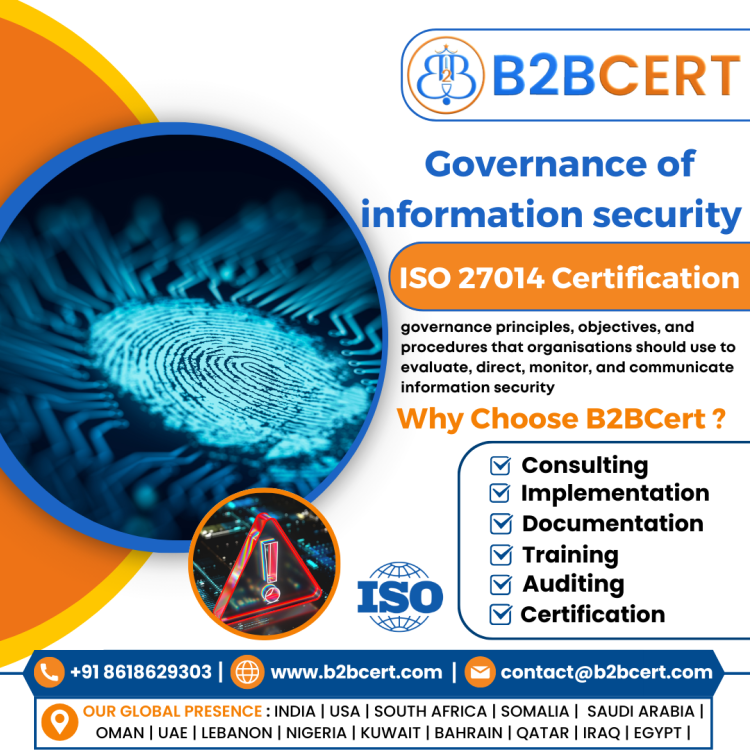How Does ISO 27014 Guide the Implementation of Audit and Review Processes?

In today’s data-driven world, organizations face growing challenges in managing and protecting information assets. ISO 27014, also known as the Information Security Governance Standard, provides a strategic framework for organizations to effectively govern information security (IS). One of the critical aspects of ISO 27014 is its guidance on the implementation of audit and review processes, ensuring that organizations maintain accountability, transparency, and continual improvement in their security posture.
For businesses seeking ISO 27014 Certification in Singapore, understanding how this standard shapes audit and review mechanisms is key to achieving long-term governance maturity and information assurance.
Understanding ISO 27014 and Its Role in Governance
ISO 27014 focuses on establishing a strong governance structure for information security. Unlike ISO 27001, which deals with management systems and operational controls, ISO 27014 addresses the strategic oversight required by top management and boards. It ensures that information security aligns with organizational objectives, resources are properly allocated, and risks are managed effectively.
The standard’s framework includes principles such as responsibility, strategy alignment, acquisition, performance, and conformance — all of which directly influence how audit and review processes are structured and executed.
The Purpose of Audit and Review in ISO 27014
Audit and review processes serve as the backbone of continuous improvement within an organization’s information security governance. ISO 27014 emphasizes these processes to ensure that:
-
Policies and strategies are effective and align with business goals.
-
Information security investments yield measurable outcomes.
-
Governance decisions are based on accurate, evidence-backed assessments.
-
Compliance obligations are consistently met, minimizing regulatory and reputational risks.
In essence, audits and reviews are the mechanisms that enable leaders to verify whether their governance model is working as intended and where adjustments may be necessary.
Guidelines from ISO 27014 on Implementing Audit and Review Processes
ISO 27014 outlines clear governance practices that help organizations design, execute, and maintain effective audit and review processes. These guidelines can be categorized into several key stages:
1. Establish Governance Accountability
The standard emphasizes that senior management and the governing body bear ultimate accountability for information security. This includes ensuring that independent audits and periodic reviews are performed to assess governance efficiency.
Organizations implementing ISO 27014 Services in Singapore are encouraged to define clear roles and responsibilities for auditors, internal teams, and governance committees. This ensures objectivity and impartiality during the audit process.
2. Align Audits with Strategic Objectives
ISO 27014 insists that audit activities must be aligned with organizational strategy. Reviews should assess how well information security supports the organization’s mission and risk appetite. This approach ensures that security governance isn’t isolated from business decision-making but integrated into the overall corporate framework.
3. Use Performance Metrics and Indicators
A key principle of ISO 27014 is performance measurement. The standard recommends using Key Performance Indicators (KPIs) and Key Risk Indicators (KRIs) to evaluate the effectiveness of governance controls. These metrics form the basis for meaningful audits and facilitate informed reviews by top management.
For example, an organization may measure incident response time, policy compliance rates, or user awareness levels to assess governance effectiveness.
4. Ensure Continuous Improvement
Audits are not one-time events under ISO 27014—they are part of a continuous improvement cycle. The review outcomes should feed into corrective and preventive actions. Organizations should regularly reassess their governance strategies, ensuring they remain resilient to emerging threats and evolving regulations.
5. Foster Transparency and Reporting
Effective governance requires transparent reporting. ISO 27014 recommends that audit findings and review outcomes be communicated to relevant stakeholders, including board members and regulatory bodies. This transparency enhances accountability and helps maintain stakeholder trust.
6. Integrate with ISO 27001 Audits
While ISO 27014 provides governance-level guidance, it can be integrated with operational audits conducted under ISO 27001. This combined approach ensures that both strategic and technical aspects of information security are evaluated holistically.
Benefits of Implementing ISO 27014-Based Audit and Review Processes
Implementing audit and review mechanisms in line with ISO 27014 offers several strategic advantages for organizations in Singapore and beyond:
-
Enhanced Decision-Making: Leaders gain data-driven insights for effective governance.
-
Improved Risk Management: Audits identify gaps and help in prioritizing mitigation measures.
-
Regulatory Compliance: Regular reviews ensure adherence to privacy and data protection laws.
-
Stakeholder Confidence: Transparent governance enhances trust among clients, partners, and regulators.
-
Sustained Business Resilience: Continuous improvement fosters adaptability in a changing security landscape.
Organizations engaging ISO 27014 Consultants in Singapore can benefit from expert guidance in designing governance frameworks that comply with the standard while being tailored to business-specific needs.
Steps to Implement ISO 27014 Audit and Review Processes
Organizations pursuing ISO 27014 Certification in Singapore can follow a structured approach:
-
Gap Analysis: Evaluate current governance and audit practices against ISO 27014 guidelines.
-
Policy Development: Define audit objectives, scope, and responsibilities.
-
Framework Integration: Align ISO 27014 governance with ISO 27001 and other ISO standards.
-
Auditor Training: Build internal audit competencies or hire certified external consultants.
-
Conduct Periodic Audits: Perform regular internal and external audits to measure performance.
-
Management Reviews: Discuss audit results and implement strategic improvements.
By following these steps, organizations can strengthen their information security governance and build a culture of accountability.
Conclusion
ISO 27014 serves as a strategic guide for establishing robust governance in information security. Its emphasis on audit and review processes helps organizations ensure that their information security efforts are not only effective but also aligned with business goals.
For companies in Singapore, adopting ISO 27014 means moving beyond compliance—it’s about building confidence, resilience, and trust in the digital age. Whether you seek ISO 27014 Certification in Singapore, or wish to partner with leading ISO 27014 Consultants in Singapore, B2B Cert offers comprehensive ISO 27014 Services in Singapore to help your organization implement effective governance frameworks and achieve certification success.
What's Your Reaction?



























